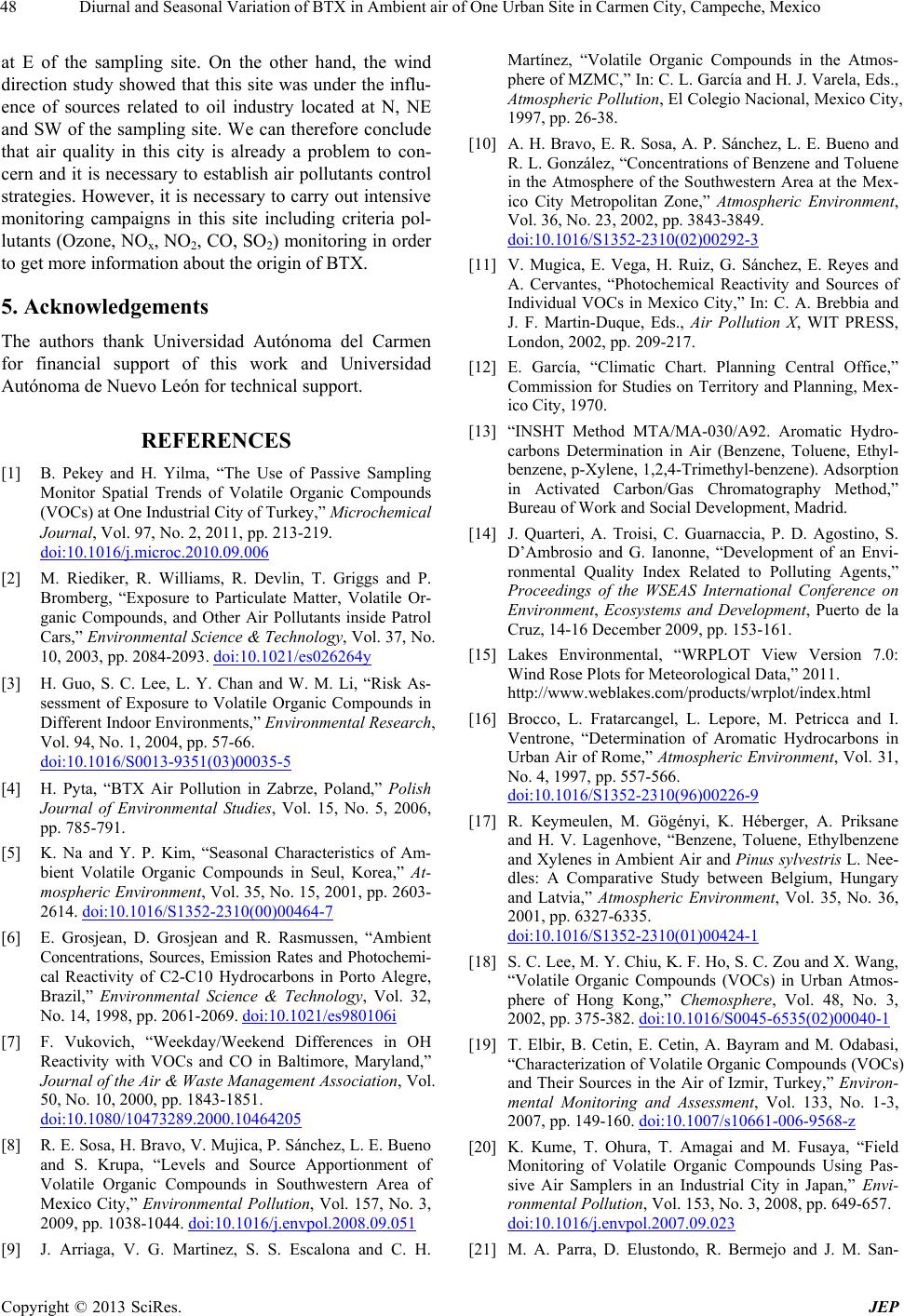
Diurnal and Seasonal Variation of BTX in Ambient air of One Urban Site in Carmen City, Campeche, Mexico
48
at E of the sampling site. On the other hand, the wind
direction study showed that this site was under the influ-
ence of sources related to oil industry located at N, NE
and SW of the sampling site. We can therefore conclude
that air quality in this city is already a problem to con-
cern and it is necessary to establish air pollutants control
strategies. However, it is necessary to carry out intensive
monitoring campaigns in this site including criteria pol-
lutants (Ozone, NOx, NO2, CO, SO2) monitoring in order
to get more information about the origin of BTX.
5. Acknowledgements
The authors thank Universidad Autónoma del Carmen
for financial support of this work and Universidad
Autónoma de Nuevo León for technical support.
REFERENCES
[1] B. Pekey and H. Yilma, “The Use of Passive Sampling
Monitor Spatial Trends of Volatile Organic Compounds
(VOCs) at One Industrial City of Turkey,” Microchemical
Journal, Vol. 97, No. 2, 2011, pp. 213-219.
doi:10.1016/j.microc.2010.09.006
[2] M. Riediker, R. Williams, R. Devlin, T. Griggs and P.
Bromberg, “Exposure to Particulate Matter, Volatile Or-
ganic Compounds, and Other Air Pollutants inside Patrol
Cars,” Environmental Science & Technology, Vol. 37, No.
10, 2003, pp. 2084-2093. doi:10.1021/es026264y
[3] H. Guo, S. C. Lee, L. Y. Chan and W. M. Li, “Risk As-
sessment of Exposure to Volatile Organic Compounds in
Different Indoor Environments,” Environmental Research,
Vol. 94, No. 1, 2004, pp. 57-66.
doi:10.1016/S0013-9351(03)00035-5
[4] H. Pyta, “BTX Air Pollution in Zabrze, Poland,” Polish
Journal of Environmental Studies, Vol. 15, No. 5, 2006,
pp. 785-791.
[5] K. Na and Y. P. Kim, “Seasonal Characteristics of Am-
bient Volatile Organic Compounds in Seul, Korea,” At-
mospheric Environment, Vol. 35, No. 15, 2001, pp. 2603-
2614. doi:10.1016/S1352-2310(00)00464-7
[6] E. Grosjean, D. Grosjean and R. Rasmussen, “Ambient
Concentrations, Sources, Emission Rates and Photochemi-
cal Reactivity of C2-C10 Hydrocarbons in Porto Alegre,
Brazil,” Environmental Science & Technology, Vol. 32,
No. 14, 1998, pp. 2061-2069. doi:10.1021/es980106i
[7] F. Vukovich, “Weekday/Weekend Differences in OH
Reactivity with VOCs and CO in Baltimore, Maryland,”
Journal of the Air & Waste Management Association, Vol.
50, No. 10, 2000, pp. 1843-1851.
doi:10.1080/10473289.2000.10464205
[8] R. E. Sosa, H. Bravo, V. Mujica, P. Sánchez, L. E. Bueno
and S. Krupa, “Levels and Source Apportionment of
Volatile Organic Compounds in Southwestern Area of
Mexico City,” Environmental Pollution, Vol. 157, No. 3,
2009, pp. 1038-1044. doi:10.1016/j.envpol.2008.09.051
[9] J. Arriaga, V. G. Martinez, S. S. Escalona and C. H.
Martínez, “Volatile Organic Compounds in the Atmos-
phere of MZMC,” In: C. L. García and H. J. Varela, Eds.,
Atmospheric Pollution, El Colegio Nacional, Mexico City,
1997, pp. 26-38.
[10] A. H. Bravo, E. R. Sosa, A. P. Sánchez, L. E. Bueno and
R. L. González, “Concentrations of Benzene and Toluene
in the Atmosphere of the Southwestern Area at the Mex-
ico City Metropolitan Zone,” Atmospheric Environment,
Vol. 36, No. 23, 2002, pp. 3843-3849.
doi:10.1016/S1352-2310(02)00292-3
[11] V. Mugica, E. Vega, H. Ruiz, G. Sánchez, E. Reyes and
A. Cervantes, “Photochemical Reactivity and Sources of
Individual VOCs in Mexico City,” In: C. A. Brebbia and
J. F. Martin-Duque, Eds., Air Pollution X, WIT PRESS,
London, 2002, pp. 209-217.
[12] E. García, “Climatic Chart. Planning Central Office,”
Commission for Studies on Territory and Planning, Mex-
ico City, 1970.
[13] “INSHT Method MTA/MA-030/A92. Aromatic Hydro-
carbons Determination in Air (Benzene, Toluene, Ethyl-
benzene, p-Xylene, 1,2,4-Trimethyl-benzene). Adsorption
in Activated Carbon/Gas Chromatography Method,”
Bureau of Work and Social Development, Madrid.
[14] J. Quarteri, A. Troisi, C. Guarnaccia, P. D. Agostino, S.
D’Ambrosio and G. Ianonne, “Development of an Envi-
ronmental Quality Index Related to Polluting Agents,”
Proceedings of the WSEAS International Conference on
Environment, Ecosystems and Development, Puerto de la
Cruz, 14-16 December 2009, pp. 153-161.
[15] Lakes Environmental, “WRPLOT View Version 7.0:
Wind Rose Plots for Meteorological Data,” 2011.
http://www.weblakes.com/products/wrplot/index.html
[16] Brocco, L. Fratarcangel, L. Lepore, M. Petricca and I.
Ventrone, “Determination of Aromatic Hydrocarbons in
Urban Air of Rome,” Atmospheric Environment, Vol. 31,
No. 4, 1997, pp. 557-566.
doi:10.1016/S1352-2310(96)00226-9
[17] R. Keymeulen, M. Gögényi, K. Héberger, A. Priksane
and H. V. Lagenhove, “Benzene, Toluene, Ethylbenzene
and Xylenes in Ambient Air and Pinus sylvestris L. Nee-
dles: A Comparative Study between Belgium, Hungary
and Latvia,” Atmospheric Environment, Vol. 35, No. 36,
2001, pp. 6327-6335.
doi:10.1016/S1352-2310(01)00424-1
[18] S. C. Lee, M. Y. Chiu, K. F. Ho, S. C. Zou and X. Wang,
“Volatile Organic Compounds (VOCs) in Urban Atmos-
phere of Hong Kong,” Chemosphere, Vol. 48, No. 3,
2002, pp. 375-382. doi:10.1016/S0045-6535(02)00040-1
[19] T. Elbir, B. Cetin, E. Cetin, A. Bayram and M. Odabasi,
“Characterization of Volatile Organic Compounds (VOCs)
and Their Sources in the Air of Izmir, Turkey,” Environ-
mental Monitoring and Assessment, Vol. 133, No. 1-3,
2007, pp. 149-160. doi:10.1007/s10661-006-9568-z
[20] K. Kume, T. Ohura, T. Amagai and M. Fusaya, “Field
Monitoring of Volatile Organic Compounds Using Pas-
sive Air Samplers in an Industrial City in Japan,” Envi-
ronmental Pollution, Vol. 153, No. 3, 2008, pp. 649-657.
doi:10.1016/j.envpol.2007.09.023
[21] M. A. Parra, D. Elustondo, R. Bermejo and J. M. San-
Copyright © 2013 SciRes. JEP